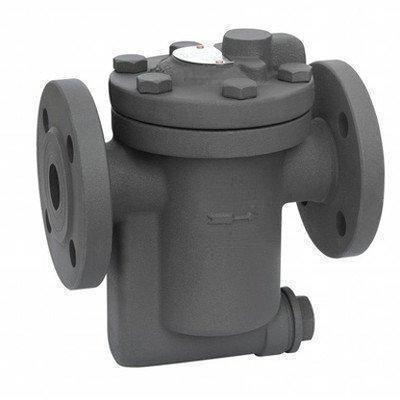
Common Mistakes in Steam Drainage Systems and Troubleshooting Methods for Drain Valves
Common misconceptions in steam drainage systems

Misunderstanding of flashing steam:
Many users mistakenly consider flashing steam as air leakage, and when they see "white smoke" coming out of the drain valve outlet, they mistakenly think it is air leakage. In fact, those "white smoke" are flashing steam. When high-temperature and high-pressure condensate is discharged into the low-pressure zone, the total enthalpy remains unchanged while the sensible heat decreases. The heat released vaporizes some of the water to produce steam, which is called flash steam. Flash steam is a normal phenomenon. The flash steam flow rate is low and appears "white", which can be seen at the outlet of the drain valve; If the steam trap leaks, the steam will continuously spray out. The straight exhaust steam is colorless and accompanied by high speed and pressure. Therefore, after a distance from the outlet pipeline of the steam trap, a white "steam column" can be seen spewing out at high speed, which is a section of "steam column", indicating that the steam trap has steam leakage.
Misconceptions about the issue of series hydrophobicity
Some customers have connected two drain valves in series at the equipment outlet to prevent steam leakage due to the failure of the drain valve. This can lead to the following problems: 1) The condensed water flashes at the outlet of the first drain valve due to a pressure drop, causing the latter to steam lock and causing water accumulation in the equipment; 2) When two drain valves are connected in series, the pressure difference before and after each drain valve decreases. Originally, a single small diameter drain valve could meet the requirements, but when connected in series, two large diameter drain valves are required, resulting in greater waste.
Lack of understanding of group hydrophobicity
Group drainage refers to multiple devices or different heating sections of a device sharing a drainage valve. This phenomenon is very common, and group drainage has the following hazards: 1. Group drainage can cause pressure imbalance. 2. Problems such as water accumulation and water hammer inside the equipment. 3. Causing equipment damage. 4. Uneven heating.
The importance of steam system drainage is seriously underestimated, but in fact, it is very important for the safety production, quality and efficiency improvement, energy conservation and emission reduction of enterprises. Eliminating hydrophobic misconceptions is the first step towards correct and effective hydrophobic behavior.
Solution to drain valve malfunction
A steam trap is a valve that automatically removes condensed water, air, and non condensable gases, while also preventing steam leakage. In practical work, if the drain valve malfunctions, we suggest that the problem can be solved from the following two aspects.
When the drain valve does not operate and condensate is not discharged
The prolonged inaction of the steam trap valve results in a decrease in the surface temperature of the valve body, which is an abnormal condition where the steam trap valve cannot function properly. The reason for this failure is:
1) The pipeline or filter is blocked by impurities and dirt, and condensate cannot flow into the steam trap. It is necessary to clean the pipeline, filter, and the dirt inside the valve.
2) The valve core and valve seat of the steam trap are blocked by garbage and should be cleaned.
3) The pressure of the gas equipment exceeds the maximum working pressure of the steam trap, which prevents the steam trap from opening. It is necessary to replace the steam trap valve with a higher working pressure or adjust and reduce the working pressure of the gas equipment.
4) Without draining condensate, steam traps are hot and can cause steam blockage caused by steam or secondary steam. Once the steam is condensed, the steam blockage disappears. This is due to the improper installation of the steam trap valve, which prevents condensation water from being trapped midway through the inlet.
5) If the amount of condensate discharged after the steam trap is very small or the action time interval is long, it is necessary to replace the steam trap with a small displacement.
6) If a vacuum occurs in the heat exchange equipment, a vacuum breaker needs to be installed in the steam system.
The drain valve continuously discharges water and continuously sprays steam
1) If the steam trap continuously discharges condensate without closing, it is necessary to replace the large displacement trap.
2) If the steam trap continuously drains and exhausts steam, it may be due to foreign objects sandwiched between the valve core and valve seat or impurities sandwiched on the guide surface. Simply remove and clean the foreign objects.
3) If the bimetallic sheet of the emptying device deforms, making it impossible to close the steam drain valve, it is necessary to replace the failed bimetallic sheet.
4) Incorrect installation of steam trap valves can also cause the phenomenon of spraying and not closing the valve. It is necessary to install according to the installation diagram provided by the manufacturer.
The necessity of installing exhaust valves in steam traps
Although the steam trap has a cold exhaust performance when starting, due to its installation position below the equipment, only a portion of the air can be discharged. Some of the air will still accumulate in the interlayer opposite the steam inlet pipe of the equipment, and the front steam pressure makes it impossible for this air to be discharged through the lower steam trap. Air accumulation inside the equipment will have the following adverse consequences:
1) The air has a high thermal resistance, which reduces heating efficiency.
2) Air can cause corrosion to equipment.
3) The presence of air can mislead the pressure gauge reading.
4) The most serious issue is the generation of waste due to heating.
Categories
Recent Posts
Copyright © 2024 Tonglu Yongxin Valve Co.,Ltd.All Rights Reserved. Powered by dyyseo.com

IPv6 network supported